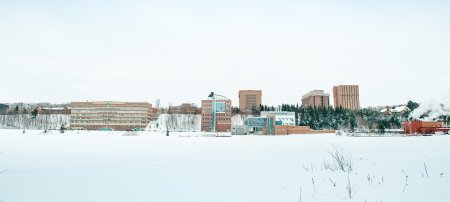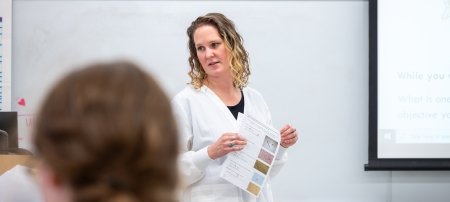High-Tech Classrooms Usher in a New Era of Teaching

Gordon Parker hoped the new classroom would improve the learning experience for one of his graduate classes. He didn’t expect to cover nearly a third more material.
“It’s crazy,” says the John and Cathi Drake Professor in Mechanical Engineering at Michigan Technological University. “I’ve never been able to get that far with this class. And it’s not like I just opened up the hose and talked faster.”
Parker’s class in linear control system and design was a guinea pig of sorts for a new classroom, Room 402 in the R. L. Smith Mechanical Engineering-Engineering Mechanics Building. Named “The Fernstrum Family Adaptable Classroom,” it has been decked out with a dazzling array of instructional gadgetry.
The point is to let students stop taking notes and immerse themselves in the class, says Director of Audiovisual Services David Chard, who designed the classroom. To that end, nearly everything that happens there is recorded and saved on the web. After class, Parker can email a link to students so they can review the material. A video camera records the teacher, voice recorders capture students’ questions and comments, and two projectors display information from iPads and laptops on screens. They allow the instructor to write over the image on the screen, and they also project larger-than-life images of 3D objects to show the class in detail.
The audiovisual system turns on automatically at the beginning of class, so Parker can teach without thinking about the technology. “It doesn’t take much time, so it enhances his teaching,” says Chard.
The class also features easels along the walls and student desks on rollers, allowing them to form small discussion groups.
These bells and whistles, and those across the hall in Room 406, come to Michigan Tech courtesy of the families of Paul Fernstrum ’65 and his sons, Sean ’90 and Todd ’92.
“When the Generations of Discovery campaign started four years ago, the family business was doing well, and we wanted to make a gift,” said Paul, president of R. W. Fernstrum and Company, which manufactures heat exchangers for marine engines. He and his sons initially decided to donate $100,000, splitting the money among the programs in which they had been enrolled. Sean, who earned a degree in scientific and technical communication, supported the humanities department’s HDMZ student computing lab. Todd, an electromechanical engineering graduate, provided funding for a 3D printer in the School of Technology.
And at the suggestion of Bill Predebon, chair of mechanical engineering-engineering mechanics, Paul donated his share to support classroom technology. Then that gift blossomed.
“Bill told me he had an idea about a classroom that would cost $85,000,” said Paul. “I talked my with sons, and we decided to go with it.” They also supported Predebon’s second vision: another high-tech classroom across the hall, but with more-modest equipment, which would cost $45,000.
“We felt we could make the investment,” Paul said. “It’s paying it forward. I’ve been able to use the disciplines I learned at Michigan Tech throughout my whole life.”
The new classrooms were inspired by the department’s revision of its mechanical engineering curriculum, which is now in progress.
“The faculty’s revisions include not only course changes but pedagogical changes that involve the use of modern instructional technology,” said Predebon. “So, I needed funds to remodel classrooms. I then approached Paul Fernstrum, explained our vision for the ME curriculum revision, asked for his help, and he and his family stepped up to the plate.”
“We are so grateful to the Fernstrum families for making this possible,” Predebon added. “These classrooms will change the way faculty teach and students learn.”
That is already happening. The new technology prompted Parker to adopt a format more common in small liberal arts classes: students complete a reading and come prepared to discuss the material, rather than learning the material from a lecture and studying the concepts later on their own. “That lets us home in on the difficult concepts in class,” he said. “This room really lends itself to that. And the students really like it; they are excited about coming to class.”
“It was a lot of work, because all of a sudden I had to prepare more stuff for class,” Parker said. “But they learned 32 percent more material. That’s huge. By an order of magnitude, this new technology is my favorite thing in terms of teaching.”
Michigan Technological University is an R1 public research university founded in 1885 in Houghton, and is home to nearly 7,500 students from more than 60 countries around the world. Consistently ranked among the best universities in the country for return on investment, Michigan's flagship technological university offers more than 185 undergraduate and graduate degree programs in science and technology, engineering, computing, forestry, business, health professions, humanities, mathematics, social sciences, and the arts. The rural campus is situated just miles from Lake Superior in Michigan's Upper Peninsula, offering year-round opportunities for outdoor adventure.




Comments